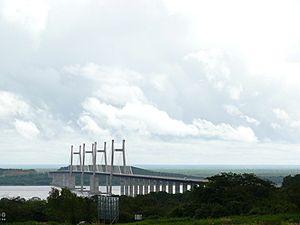Orinoquia Bridge facts for kids
Quick facts for kids Orinoquia Bridge |
|
|---|---|
 |
|
| Coordinates | 08°16′24″N 62°53′02″W / 8.27333°N 62.88389°W |
| Carries | road traffic, rail traffic |
| Crosses | Orinoco |
| Locale | Ciudad Guayana |
| Characteristics | |
| Design | Cable stayed |
| Total length | 3,156 metres (10,354 ft) |
| Longest span | 300 metres (984 ft) |
| Clearance above | 41 metres (135 ft) |
| History | |
| Opened | 13 November 2006 |
The Orinoquia Bridge, also called the Second Orinoco crossing, is a very important bridge in Venezuela. It crosses the huge Orinoco River close to the city of Ciudad Guayana. This impressive bridge was officially opened on November 13, 2006. It's special because it allows both cars and trains to cross the river! Before it was built, the only other bridge over the Orinoco was the Angostura Bridge, which is about 100 kilometers upstream.
Contents
Building the Orinoquia Bridge
The place chosen for the Orinoquia Bridge is where the Orinoco River is about three kilometers (nearly two miles) wide. The river here has two main paths for boats, with a small island in the middle. You can see this island when the water level is low.
The bridge itself is made up of about 4.5 kilometers (2.8 miles) of structures. It has four lanes for cars, split into two separate roadways. In the very middle, there's a single railway track for trains.
How the Bridge is Designed
The main part of the Orinoquia Bridge is a "cable-stayed" design. This means strong cables hold up the bridge deck from tall towers.
- It has two main sections, each 300 meters (984 feet) long, that go over the river.
- These sections are held up by four H-shaped towers, each 120 meters (394 feet) tall.
- The bridge is high enough for ships to pass underneath, with 41 meters (135 feet) of space above the water.
- Unlike some other cable-stayed bridges, these two main sections don't connect directly. Instead, they are anchored to the small island in the middle of the river.
There are also long sections leading up to the main bridge. The southern approach is 1320 meters (4,331 feet) long, and the northern approach is 636 meters (2,087 feet) long.
Why the Bridge is Important
The Orinoquia Bridge was built to help the older Angostura Bridge. It also creates a more direct path to the important industrial city of Ciudad Guayana.
One big reason for building this bridge was to add a railway connection. This railway will help transport heavy industrial products from Ciudad Guayana to ports on Venezuela's Caribbean coast. Even though large ships can travel on the Orinoco River, it often needs to be cleaned out (dredged) because of all the dirt and sand it carries.
The bridge also makes it easier for Venezuela to connect with Brazil to the south. This is important for Brazil to send its goods to other countries. That's why the president of Brazil at the time, Luiz Inácio Lula da Silva, came to the opening ceremony with Venezuela's president, Hugo Chávez.
Near the Orinoquia Bridge, there's also the Orinoco River Crossing for power lines. The towers for these power lines are actually the tallest man-made structures in South America!
See also
 In Spanish: Puente Orinoquia para niños
In Spanish: Puente Orinoquia para niños
- List of road-rail bridges

